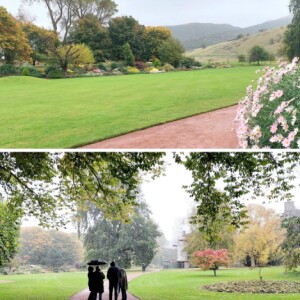Holyrood Palace grounds in a heavy downpour with a polyhedral sundial which apparently Charles I gave to his wife Henrietta Maria when he was crowned at Holyrood Abbey in 1633. Its head contains twenty facets covered with hollows of various shapes, circles, triangles, hearts and quaint faces, which cast shadows to mark the hours.
Multi-facetted dials were a particular cultural feature of Scotland in the 16th and 17th century and it is thought that Scotland had more of this type of dial than any other country in Europe. They are very rare and comprise a number of small dials of varying sizes and shapes, each with differently aligned gnomons and markings and they required great mathematical skill to produce. One of the gnomons here is the nose of a grotesque face, another is a thistle. It is thought that the Scottish fascination with mathematics encouraged the building of these complicated dials, which could also serve as unusual garden ornaments.
This is number 45 of my series on sundials.

Comments
Sign in or get an account to comment.


